Faced with a sharp decline in the number of Chinese tourists, the Korean tourism industry plans to attract visitors from neighboring countries and Southeast Asian countries, including Vietnam.
Chinese tourists accounted for nearly half of the 16 million foreign visitors to South Korea in 2016, but this year has decreased 21.9% compared to the same period last year (March 1-19), according to the latest data from the Ministry of Culture, Sports and Tourism of South Korea. In addition, only about 200,000 Southeast Asian tourists visited South Korea in 2016, according to Korea Portal.

The decline came after Chinese tourists boycotted tours to South Korea, part of a retaliation against South Korea’s decision to deploy the Terminal High Altitude Area Defense (THAAD) missile defense system. In addition, many Korean pop culture works were banned from import, and a series of Lotte stores in China were forced to close.
"It's time for us to restructure the Korean tourism industry, which has relied on Chinese tourists. This has not brought in much profit, as most Chinese tourists come here on cheap tour packages. Perhaps we can actually earn more if we solve the problems inherent in the tourism industry," said Nam Sang-man, director of the Seoul Tourism Association. Analysts say the most urgent task for Korean tourism is to diversify the nationality of foreign tourists.
Open to Southeast Asian tourists
On March 22, the Ministry of Culture, Sports and Tourism of South Korea announced plans to promote Korean tourism abroad, including establishing branches of the Korea Tourism Organization in Mongolia and Kazakhstan, and holding tourism fairs in Singapore, Japan, India and Vietnam.
The South Korean government said it is gradually increasing flights to and from Southeast Asian countries, including Japan, Mongolia, and Taiwan, and will allow electronic visas to be issued to Southeast Asian tourists starting in May, according to Yonhap News. The plan was originally planned to launch in the second half of the year, according to the Korea Herald.
In particular, South Korea will waive five-day visas for Southeast Asian tourists to Jeju Island, transiting at Incheon and Gimhae airports, enabling them to visit Seoul and southern cities. "We have seen an increase in the number of Southeast Asian tourists visiting South Korea recently. We are rushing to implement tourism promotion packages in the first half of this year," said Hwang Myung-seon, a senior official in charge of tourism at the Ministry of Culture, Sports and Tourism.
The South Korean tourism industry is working to encourage domestic airlines to expand routes to Southeast Asia and Japan, while seeking to pave the way for them to strengthen cooperation with airlines from the Philippines, Taiwan (China) and Mongolia.
In addition, the government will set aside a special loan worth 225 billion won ($200.2 million) to help affected tourism agencies resolve financial problems.


































